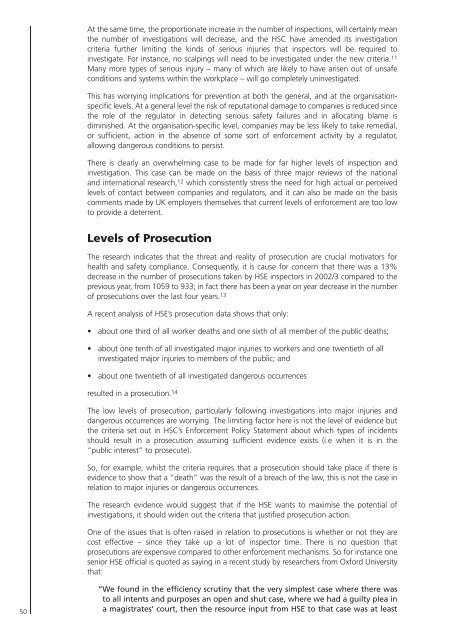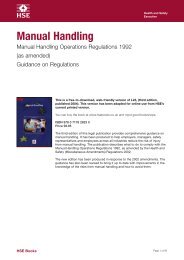Making Companies Safe - what works? (CCA ... - Unite the Union
Making Companies Safe - what works? (CCA ... - Unite the Union
Making Companies Safe - what works? (CCA ... - Unite the Union
You also want an ePaper? Increase the reach of your titles
YUMPU automatically turns print PDFs into web optimized ePapers that Google loves.
At <strong>the</strong> same time, <strong>the</strong> proportionate increase in <strong>the</strong> number of inspections, will certainly mean<br />
<strong>the</strong> number of investigations will decrease, and <strong>the</strong> HSC have amended its investigation<br />
criteria fur<strong>the</strong>r limiting <strong>the</strong> kinds of serious injuries that inspectors will be required to<br />
investigate. For instance, no scalpings will need to be investigated under <strong>the</strong> new criteria. 11<br />
Many more types of serious injury – many of which are likely to have arisen out of unsafe<br />
conditions and systems within <strong>the</strong> workplace – will go completely uninvestigated.<br />
This has worrying implications for prevention at both <strong>the</strong> general, and at <strong>the</strong> organisationspecific<br />
levels. At a general level <strong>the</strong> risk of reputational damage to companies is reduced since<br />
<strong>the</strong> role of <strong>the</strong> regulator in detecting serious safety failures and in allocating blame is<br />
diminished. At <strong>the</strong> organisation-specific level, companies may be less likely to take remedial,<br />
or sufficient, action in <strong>the</strong> absence of some sort of enforcement activity by a regulator,<br />
allowing dangerous conditions to persist.<br />
There is clearly an overwhelming case to be made for far higher levels of inspection and<br />
investigation. This case can be made on <strong>the</strong> basis of three major reviews of <strong>the</strong> national<br />
and international research, 12 which consistently stress <strong>the</strong> need for high actual or perceived<br />
levels of contact between companies and regulators, and it can also be made on <strong>the</strong> basis<br />
comments made by UK employers <strong>the</strong>mselves that current levels of enforcement are too low<br />
to provide a deterrent.<br />
Levels of Prosecution<br />
The research indicates that <strong>the</strong> threat and reality of prosecution are crucial motivators for<br />
health and safety compliance. Consequently, it is cause for concern that <strong>the</strong>re was a 13%<br />
decrease in <strong>the</strong> number of prosecutions taken by HSE inspectors in 2002/3 compared to <strong>the</strong><br />
previous year, from 1059 to 933; in fact <strong>the</strong>re has been a year on year decrease in <strong>the</strong> number<br />
of prosecutions over <strong>the</strong> last four years. 13<br />
A recent analysis of HSE’s prosecution data shows that only:<br />
• about one third of all worker deaths and one sixth of all member of <strong>the</strong> public deaths;<br />
• about one tenth of all investigated major injuries to workers and one twentieth of all<br />
investigated major injuries to members of <strong>the</strong> public; and<br />
• about one twentieth of all investigated dangerous occurrences<br />
resulted in a prosecution. 14<br />
The low levels of prosecution, particularly following investigations into major injuries and<br />
dangerous occurrences are worrying. The limiting factor here is not <strong>the</strong> level of evidence but<br />
<strong>the</strong> criteria set out in HSC’s Enforcement Policy Statement about which types of incidents<br />
should result in a prosecution assuming sufficient evidence exists (i.e when it is in <strong>the</strong><br />
“public interest” to prosecute).<br />
So, for example, whilst <strong>the</strong> criteria requires that a prosecution should take place if <strong>the</strong>re is<br />
evidence to show that a “death” was <strong>the</strong> result of a breach of <strong>the</strong> law, this is not <strong>the</strong> case in<br />
relation to major injuries or dangerous occurrences.<br />
The research evidence would suggest that if <strong>the</strong> HSE wants to maximise <strong>the</strong> potential of<br />
investigations, it should widen out <strong>the</strong> criteria that justified prosecution action.<br />
One of <strong>the</strong> issues that is often raised in relation to prosecutions is whe<strong>the</strong>r or not <strong>the</strong>y are<br />
cost effective – since <strong>the</strong>y take up a lot of inspector time. There is no question that<br />
prosecutions are expensive compared to o<strong>the</strong>r enforcement mechanisms. So for instance one<br />
senior HSE official is quoted as saying in a recent study by researchers from Oxford University<br />
that:<br />
50<br />
“We found in <strong>the</strong> efficiency scrutiny that <strong>the</strong> very simplest case where <strong>the</strong>re was<br />
to all intents and purposes an open and shut case, where we had a guilty plea in<br />
a magistrates’ court, <strong>the</strong>n <strong>the</strong> resource input from HSE to that case was at least
















